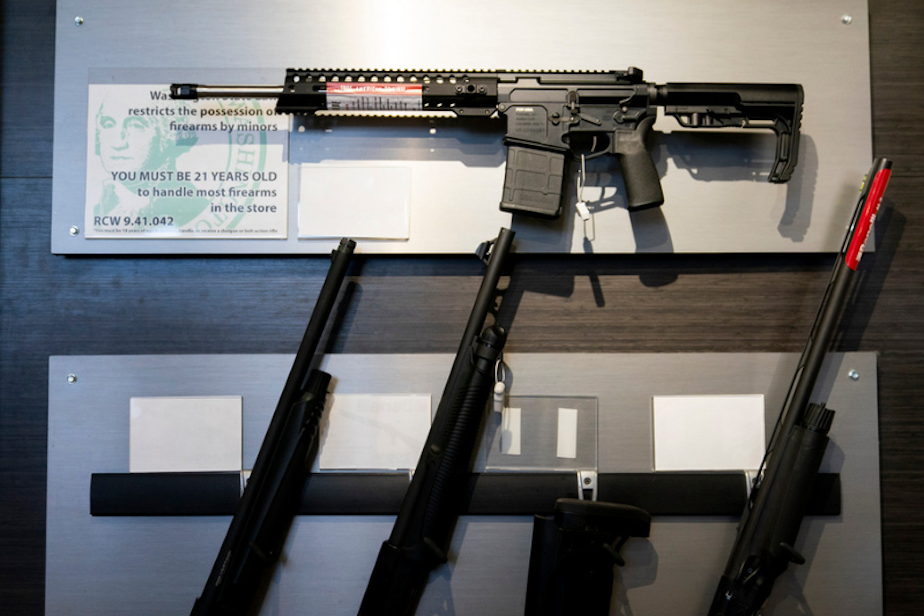What's in a name, like 'assault weapon'?: Today So Far

KUOW's Bill Radke had a dilemma when he had to talk on air about how Washington state passed an assault weapon ban last session. The issue was, that term "assault weapon." There's a lot bound up in that term, including an ethical question for journalists.
This post originally appeared in KUOW's Today So Far newsletter for May 3, 2023.
I found myself going through the same mental and ethical debate when posting our reporting on KUOW.org.
"Every gun is an 'assault' weapon, so why even use 'assault'?" Bill said on his recent "Words in Review" segment.
The term is not descriptive enough for him. He'd rather describe and let other people characterize. Still, when he posted this segment online, and podcasted it, he had to write a headline. That headline had to effectively communicate the topic. Could he use "assault weapon"?
"I think to call it an assault weapon is to use a word to sell your point of view," Bill said. "Now, it's such a common phrase, we're just calling it what people call it, but people are calling it that because we've used it so much ... somebody could use it to hunt, right, it seems like it's taking sides, calling it an 'assault weapon,' whereas 'AR-15 style' seems more neutral."
Journalists Joseph O'Sullivan with Crosscut, and Melissa Santos with Axios, had to navigate similar decisions.
Sponsored
"Traditionally, I would go with 'semiautomatic rifles' ... that's an example of a sort of clarity and specificity," O'Sullivan said, adding that he has also opted to use the term "assault style" and sometimes "AR style" in his reporting, which he feels meets the common understanding readers have.
Santos agrees readers are aware of the concepts, but it was also more about the reporting as a whole.
"In the first sentence of that story, I clarified that these are guns that they are classifying as assault weapons, and wrote what they are using to make that justification," Santos said.
"That's why I was OK using it in a headline and explaining immediately that it is an arbitrary classification ... so I think as long as you are clear that there is some specific definition here, it can be OK to use 'assault weapons,' even though it is not my preference."
The Associated Press Stylebook, aka the Bible for reporters, instructs journalists to avoid terms like "assault weapon" due to the politicization of such words. I personally would stick with the AP style, but I also found myself thinking about this dynamic between specifics and common understandings.
Sponsored
On one hand, "assault" weapon, rifle, etc. is a bit of a marketing term, like when Gov. Inslee kept repeating "weapons of war." The civilian firearms the state banned may have historical ties to military rifles, but they're not the same. They operate very similar to many handguns that remain on the market. The AR-15 style rifle at your local gun shop is not the same as the M16 from the Vietnam War era, and not the same as the M4 a soldier on JBLM uses. Terms like these are useful to score political points, sell an idea, get a piece of legislation passed.
On the other hand, it could also be argued that the idea of an "assault weapon" has grown beyond the borders of politics. When people hear the term "assault weapon," they know exactly what is being talked about. They don't envision a BB gun, a six-shooter, a double-barreled shotgun, a proton pack, or even an E-11 blaster rifle. What comes to mind is a metal/plastic semiautomatic rifle that a soldier would be familiar with.
When ArmaLite first produced its AR-15 back in the 1950s, it was designed with soldiers in mind — lightweight with plenty more cartridges. When Mikhail Kalashnikov designed the AK-47, it was for the Soviet military. The engineering was so efficient, that it has been woven into modern rifles ever since. Firearm fans are likely to nitpick what I'm about to say, but despite these firearms having different histories, somewhat different engineering, pros and cons, they are essentially the same idea — a cartridge sends a bullet out the barrel, the expanding gas moves the inner workings of the rifle to eject the casing and load another cartridge. Nitpicking any of this is like debating the differences between a Toyota and a Ford. Fuel goes into both, engines go bang bang, wheels move, and exhaust goes out. If I say, "car," this is what you are thinking about. You don't think of a bicycle, or a motorcycle, a dune buggy, or a Firefly-class transport ship.
So the general public does have an idea around the term "assault weapon." The term has been around for decades. It has been legally defined in federal and state laws. When Washington recently banned these firearms, it did so by defining them, citing attributes, and setting parameters. This goes beyond political marketing, while still being a political term.
Sponsored
None of what I just mentioned above gets conveyed, with all the nuance and understanding within the term "assault weapon." As such, reporters have to be careful. I opted to use the term "assault weapon" in online reporting, because that was the language defined and used in the bill at the center of the story. It was also further explained within the reporting (because sometimes you have to actually read full reporting and not just headlines to understand the news).
So how did Bill handle it in the end? Check out the most recent "Words in Review" to find out.
AS SEEN ON KUOW

Merk Nguyen (right) and her Ba, Quang Adam Nguyen (left). In this RadioActive feature, Merk shares her father’s journey from Vietnam as a teenager, and how water became an important symbol for him, and now her. (Courtesy of Merk Nguyen)
Sponsored
DID YOU KNOW?
A rescue effort for endangered rabbits is underway along the San Joaquin River National Wildlife Refuge in California. The river has gone over its banks in recent days and has prompted concerns about how well local wildlife can adapt, such as the riparian brush rabbit. It's a type of cottontail rabbit found along the coast from Oregon to California.
As the water gets higher, there are few places for these rabbits to escape. While they could hop over to neighboring farmland, some worry that they will be easy targets for predators. In the case of this rabbit, officials want to help them survive more than others. In the late 1990s, officials thought these rabbits were extinct. Despite such low numbers, they have had a small comeback since then. Officials aim to help the population recover, and that means helping them escape the flood. More than 360 rabbits have been recently captured, some while climbing trees to escape the water.
ALSO ON OUR MINDS

Sponsored
This company adopted AI. Here's what happened to its human workers
Economists found AI offers potentially great news for the economy, at least in one dimension that is crucial to improving our living standards: AI caused a group of workers to become much more productive. At the same time, however, the study also shines a spotlight on just how powerful AI is, how disruptive it might be, and suggests that this new, astonishing technology could have economic effects that change the shape of income inequality going forward.

